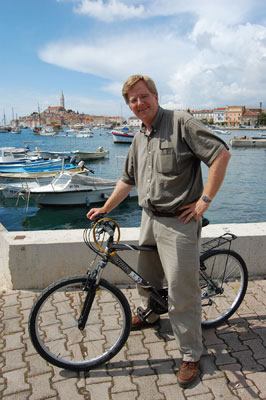Biking — a bridge over cultural barriers
This item appears on page 66 of the February 2011 issue.
Some travelers are surprised when I tell them to consider biking in Europe. I explain that it’s not only a cheap way to travel but it gets you close to the ground and close to the people. Whether you rent a bicycle for a day in a bike-friendly city like Copenhagen or decide to pedal across France for a month, you’ll experience a more local side of Europe that many travelers rarely see.
While my schedule usually won’t allow a week-long pedal in the Loire Valley, I’ll often do day trips.
Whenever I’m in Amsterdam, much of my experience is framed by my black bike handlebars — the shiny wet cobbles, powering up a bridge to coast down it and halfway to the next bridge, getting pinged by passing bikes and pinging my bell to pass others. Cars, trams, bikers and pedestrians seem to float by from all directions in silence — their sounds lost in the white noise of this dreamy city.
I feel local, efficient and even smug with my trusty and well-fitted bike. Especially during rush hour, I can get across town faster on my bike than I could by taxi or tram, giving me more time to spend at the sights.
Stockholm, Copenhagen, Berlin, Salzburg, Munich and Bruges are each a delight on two wheels, offering extensive networks of well-marked bike lanes.
Some cities have creative programs where hundreds of free or very cheap loaner bikes are locked to racks around town. While this sounds handy, the system is designed mostly for residents to grab a bike for a quick errand and can pose a challenge for tourists. Also, these bikes are very basic, sometimes in disrepair and often plastered with ads. If you’re serious about biking, pay to rent a good one from a shop instead.
For a quick but meaningful spin around town, consider a bicycle tour. Guided tours are popular in cities throughout Europe (including Amsterdam, Bruges, Paris, Munich, Berlin and Budapest). You’ll get a young, entertaining, sometimes foul-mouthed, sometimes informative guide who’ll give you a breezy introduction to the city and a close-up look at back streets few tourists ever see.
Biking in the countryside (using a small town as a springboard) is extremely popular in Europe. Thanks to the law of supply and demand, you can generally count on finding rental shops wherever there are good bike-tripping options: along the Danube, the Rhine and other idyllic river valleys; around Ireland’s Dingle Peninsula; on Greek islands, and in the Alps for mountain biking on service roads.
If you’re interested in long-distance biking, you need to define what part of Europe you want to experience and then decide whether your bicycle will be your key to freedom or an albatross around your neck.
For example, if you have the entire summer free, you and your bike can cover a lot of ground. But if you have a month or less, will you be content to focus on a single country or region? Given what you want to see in the time you have, is the slow pace of bicycling a worthwhile trade-off for the benefits? And, finally, do you want to spend much more of your time in rural and small-town Europe than in cities?
If you’re convinced that a long-distance trip is right for you, consider bringing your bike from home. Bikes are less expensive in the United States, and you’ll know the bike works well for you. Don’t forget to bring the tools you’ll need to get your bike back into riding form so you can ride straight out of your European airport.
Smart bikers travel very light. Unless you really love camping, staying in hostels, hotels or B&Bs makes more sense, since it frees you from lugging around a tent, sleeping bag and cooking equipment.
Don’t be a purist. Taking your bike on a train can greatly extend the reach of your trip, since every hour by rail saves a day that would have been spent in the saddle (and there’s nothing so sweet as taking a train away from the rain and into a sunny place).
I find that having a bike parked in the garden of my hotel is a great way to fit in and, literally, “go local.” Europeans love bicycles, and they are often genuinely impressed when they encounter Americans who reject the view from the tour-bus window in favor of huffing and puffing on two wheels. Your bike provides an instant conversation piece, the perfect bridge over a maze of cultural and language barriers.

